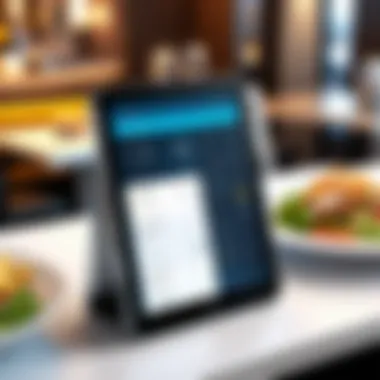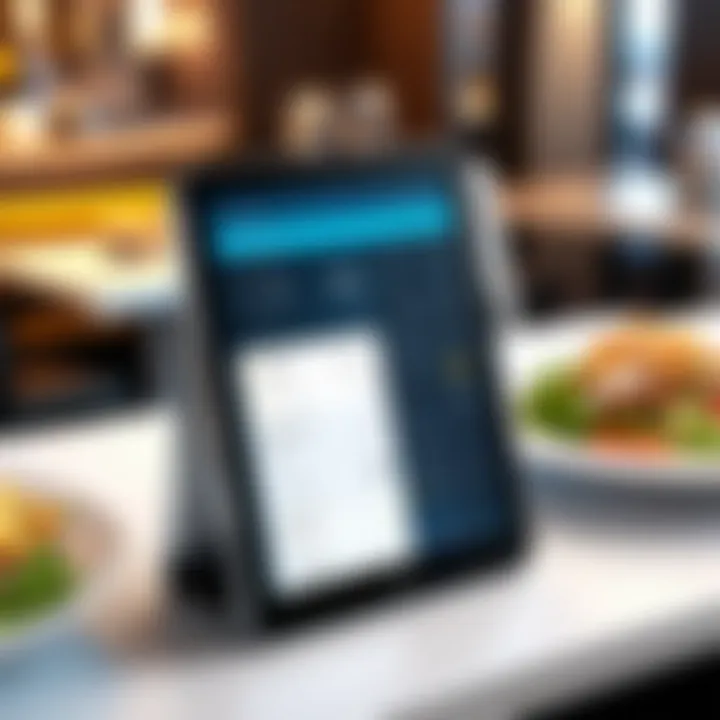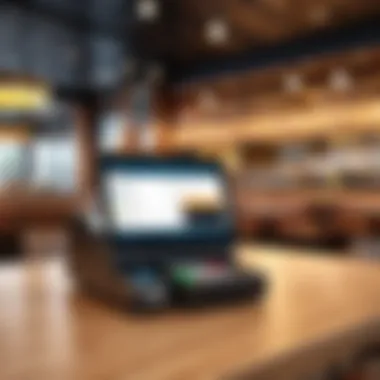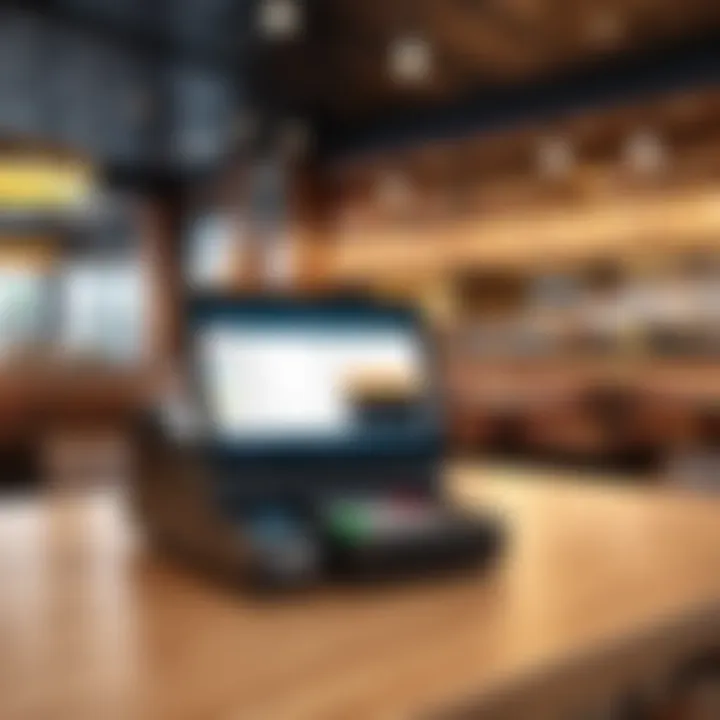Mastering Restaurant Payment Software for Efficiency


Intro
Navigating the bustling domain of the hospitality industry comes with its set of challenges. One significant aspect that restaurant owners must handle is payment processing. As technology advances, restaurant payment software has emerged as a vital tool to enhance operational efficiency. Within this framework, understanding how these software solutions work and their benefits can truly set apart successful establishments from the rest.
This guide aims to dissect the intricacies of restaurant payment software, catering specifically to software developers, IT professionals, and students keen on grasping its blend of technology and hospitality service. By diving into various aspects—from essential features to user experience—this article aspires to equip stakeholders with the knowledge to make informed decisions in their payments processes.
Overview of Software
Purpose and Use Cases
Restaurant payment software serves multiple purposes in modern operations. At its core, this software automates and streamlines payment processing activities, allowing restaurants to operate gracefully during peak hours. Its versatility allows for various use cases:
- Point of Sale (POS) Integration: Merging seamlessly with existing POS systems, enabling quick and efficient transactions.
- Mobile Payments: Catering to the surge in mobile transactions, enhancing customer convenience.
- Inventory Management: Some solutions tie payment data to stock inventory, providing insights that aid in better management.
Understanding these applications helps in selecting the right tool for specific operational needs.
Key Features
When considering which payment software to implement, certain features come to the forefront. These enhancements can affect a restaurant's bottom line and user satisfaction:
- Security: Robust encryption and compliance with standards like PCI DSS are non-negotiable.
- User Analytics: Insights into customer buying patterns allow for better marketing and promotional strategies.
- Flexible Payment Options: Accepting various payment methods—from credit cards to digital wallets—can greatly enhance customer satisfaction.
- Customizable Interfaces: User-centric design ensures that staff can navigate the software without a steep learning curve.
Such features not only optimize the payment process but fortify the overall operations of a restaurant.
In-Depth Review
Performance Analysis
Performance remains a crucial aspect of any software, especially in the fast-paced environment of restaurants. A detailed performance analysis often points towards how quickly and accurately transactions are processed.
- Speed: High-performance systems can handle transactions swiftly, ensuring that customers do not experience long waits.
- Error Rates: Lower error rates in transaction processing lead to reduced operational headaches and improved financial accuracy.
- Customer Feedback: Real-world feedback often highlights bottlenecks that affect service, pointing towards how efficient the software truly is.
User Interface and Experience
The interface and experiential aspect of restaurant payment software cannot be understated. A clean, intuitive design fosters quicker adaptability among staff.
- Ease of Use: Systems that promote streamlined data entry often result in fewer mistakes. Staff can focus more on service rather than fumbling with complicated systems.
- Training Requirements: Simpler interfaces can drastically reduce training times. Consequently, restaurant owners can save resources while ensuring a well-informed team.
"In the restaurant business, time is money—investing in efficient payment software can be the difference between success and struggle."
In summary, as the tech landscape continues to shape the culinary landscape, understanding the functions, advantages, and possible downsides of restaurant payment software is critical. This guide shall further navigate through the detailed contours of their capabilities to ensure your establishment keeps pace with modern demands, fostering both efficiency and increased customer satisfaction.
Understanding Restaurant Payment Software
In today’s fast-paced dining environment, the significance of restaurant payment software can't be overstated. This software serves as the backbone of a restaurant's financial operations, impacting everything from customer satisfaction to overall efficiency. Understanding how payment software integrates within restaurant ecosystems is crucial for restaurateurs and stakeholders alike.
The evolution and implementation of payment software are essential as they streamline various processes, reduce errors, and enhance customer experiences. When patrons swipe their cards or tap their phones to settle their bills, they often overlook the sophisticated technology making it all possible. What lies behind that quick interaction is a complex web of transaction processing and customer engagement tools that help establishments stay afloat in a competitive market.
Adopting effective restaurant payment solutions can significantly reduce the time staff spend on payment processing and, in turn, minimize the wait times for customers. These systems also contribute to robust data analytics, enabling restaurant owners to track sales trends and customer preferences, which are invaluable insights for devising marketing strategies.
Additionally, with tight margins in the restaurant industry, every bit of efficiency counts. Payment software not only curtails the risk of human errors but can also provide loyalty programs embedded within its framework, helping foster customer retention and repeat patronage without needing extensive manual input.
Definition and Purpose
Restaurant payment software refers to a suite of tools designed to facilitate financial transactions within dining establishments. At its core, the purpose of this software is simple: to enable efficient processing of payments, whether credit card, debit card, or mobile wallets. However, its implications reach far beyond mere transactions.
The software often includes features for managing customer billing, processing tips, tracking sales, and integrating with other restaurant management systems. With most establishments moving towards a cashless society, having reliable payment software is nothing short of imperative.
Its purpose also encompasses enhancing overall customer experience. A seamless payment process can leave diners with a positive impression, prompting them to return or recommend the establishment. Many of these systems offer functionalities to allow customers to split bills easily, view detailed receipts, and even leave feedback—all at their fingertips.
Historical Context
Stepping back, the journey of payment software in the restaurant sector has been intriguing. Initially, restaurant transactions relied heavily on manual cash registers and hand-written receipts. It wasn't until the late 20th century that technological advancements began to infiltrate this domain.
With the introduction of electronic point of sale (POS) systems in the 1980s, restaurants started incorporating computerized methods to improve sales tracking and inventory management. However, these early systems were relatively basic. As technology advanced and the internet became ubiquitous in the late 90s and early 2000s, the landscape of payment processing transformed once again.
Mobile payment solutions began to emerge alongside cloud computing, leading to more versatile and integrated systems. These advancements allowed restaurant owners to access their transaction data in real time from anywhere, paving the way for a new era of efficiency and insight into business operations, consumer habits, and financial forecasting.
"The evolution of restaurant payment software exemplifies the shift from manual to digital, reflecting broader changes in consumer behavior and technology."
Ultimately, today's restaurant payment software is a far cry from the rudimentary systems of the past. As eateries continue to grapple with the challenges of modern dining, understanding these historical roots provides context for the importance of leveraging advanced payment technologies in contemporary practices.
Key Features of Payment Software
Restaurant payment software comes with a variety of features that can be crucial in optimizing daily operations and enhancing customer service. Recognizing these key functionalities can help restaurant owners not only improve their payment processes but also enrich the overall experience for both staff and patrons. In this section, we’ll delve into specific elements like transaction processing, integration with point of sale (POS) systems, reporting and analytics, as well as customer engagement features to underline their effectiveness and importance.
Transaction Processing
When it comes to payment software, transaction processing is the core component. It allows restaurants to effectively manage all financial transactions efficiently and swiftly. From accepting payments through different channels—credit cards, mobile wallets, or even contactless options—this feature ensures a smooth experience.


This means no more waiting around while credit card authorizations go through. Instead, payment software can cut down processing times significantly, leading to faster table turnover. As any restaurateur will tell you, time is money, and this couldn’t be more true at peak hours. Furthermore, enhanced security protocols within this feature can protect sensitive customer data, helping to foster customer trust.
Integration with Point of Sale Systems
Imagine a seamless blend of payment software with your POS system, where everything from orders to payments operates in harmony. Integration with POS systems allows payment software to pull necessary data in real-time, minimizing errors and ensuring that transactions are not only accurate but also quick.
This integration also streamlines end-of-day financial reconciliations. For example, a bartender can simply ring up drinks, and the payment software automatically handles the transactions without complicated entry work. A real boon for busy shifts, integrating these systems leads to a less frantic environment and allows staff to focus more on providing stellar service.
Reporting and Analytics
Effective reporting and analytics tools empower restaurant owners to examine their financial health closely. Payment software can generate reports on transaction trends, peak sales times, and customer payment behaviors, among other crucial metrics. This information is invaluable for decision-making.
With layered insights, owners can identify which payment methods yield the best results or when sales slump. Maybe Wednesday evenings are a dead zone for cash payments? Recognizing such trends allows for strategic adjustments—such as special promotions or targeted marketing campaigns.
"Data will drive your business decisions. The more insights you have, the better you can plan for future success."
Customer Engagement Features
In a landscape where customer loyalty is pivotal, customer engagement features within payment software offer restaurants the tools they need to cultivate relationships with guests. Loyalty programs, personalized offers, and reminders for birthdays or anniversaries give customers reasons to return.
These tools often integrate directly into the payment process, making it simple for guests to accumulate points or redeem rewards on their next visit. Consider a scenario where a diner earns discounts on future meals simply for paying bills in a specific way. A rewarding customer experience not only enhances satisfaction but often translates into repeat business.
Types of Restaurant Payment Software
In the ever-changing landscape of the restaurant business, understanding the different types of payment software is key to streamlining operations and elevating customer satisfaction. These systems can directly influence how a restaurant manages transactions, interacts with customers, and processes data. Thus, getting a grip on the available options can make a significant difference.
Cloud-Based Solutions
Cloud-based payment software has surged in popularity, notably due to its flexibility and scalability. This type enables restaurants big and small to process payments via the internet. One of the biggest perks? Accessing the software from any location with an Internet connection, be it a busy service floor or a quieter back-of-house area. This is particularly significant for restaurant chains with multiple locations, as cloud solutions allow for centralized management of transactions across all sites.
Also, cloud-based systems usually feature automatic updates, which means restaurants don’t have to keep track of software patches or security measures; these work in the background.
However, it's worth mentioning that a solid internet connection is critical for cloud systems to perform seamlessly. Any hiccup in connectivity can lead to downtime, leaving both staff and customers frustrated.
Mobile Payment Solutions
Mobile payment solutions represent a modern shift in how customers engage with restaurants. These systems allow diners to pay directly from their smartphones, whether through apps or contactless payment options like Apple Pay and Google Wallet. This convenience resonates well—especially with tech-savvy generations wanting a hassle-free dining experience.
For restaurants, integrating mobile payment solutions can reduce wait times, enhance table turnover, and often improve tips for servers. Think about it: a customer can pay their bill right from their seat, without waiting for check processing.
Nevertheless, to implement such systems, restaurant owners need to ensure their devices are compatible and that staff are adequately trained to guide customers through the process.
On-Premise Software
On-premise software has been around for a long time and is often seen as a more traditional route for payment processing. With this option, all data is stored locally on servers housed in the restaurant itself. While this might seem old-school in a world leaning heavily towards the cloud, some businesses prefer it for its perceived security and control over their sensitive financial information.
However, on-premise solutions can be expensive regarding setup and ongoing maintenance. Also, unlike cloud-based options, updating software frequently requires manual effort. While some may appreciate this level of control, others see it as an unnecessary burden in a landscape where agility is prized.
Custom Solutions
For some establishments, a cookie-cutter approach simply won't cut it. Custom solutions offer tailored software designed to meet the specific needs of a restaurant. This could range from incorporating unique loyalty programs to specific reporting functions that standard software might lack.
Adopting a custom solution can provide a distinct advantage, ensuring that all features are directly aligned with the operational strategy. On the downside, the development process can be lengthy and costly. You need reliable software developers who understand your operational needs.
Benefits of Implementing Payment Software
Adopting advanced payment software isn’t merely a trendy move in the restaurant industry; it’s akin to upgrading a bicycle to a high-performance road bike. The efficiency, accuracy, and customer experiences that stem from leveraging this technology can substantially differentiate a restaurant from its competition. Here, we dissect these pivotal advantages to truly grasp why implementing payment solutions is essential.
Enhanced Efficiency
When it comes to restaurant operations, time is money. Implementing effective payment software can drastically cut down on transaction times, allowing waitstaff to process payments swiftly and accurately. Picture a bustling Saturday night; customers are eager to settle up and head out. Delay due to outdated methods can turn a smooth experience into a drawn-out affair.
Leveraging modern payment systems, like Square or Toast, automates much of the payment process, enabling staff to focus their energies on service rather than fiddling with cash registers. This tech upgrade allows:
- Faster Payment Processing: Streamlined transactions that cut wait times.
- Reduced Order Errors: Automated systems minimize human mistakes, enhancing service speed.
- Inventory Management: Real-time inventory updates help in keeping stock levels balanced.
In essence, enhancing operational efficiency means every second counts and builds a seamless flow in service, which is vital for customer retention.
Improved Accuracy
Mistakes happen, especially in a fast-paced environment like a restaurant. One incorrectly punched number in a transaction can lead to a domino effect of issues, from mismatched receipts to unhappy diners. Payment software helps to significantly lower these error rates, leading to substantial improvements in overall accuracy.
- Automated Calculations: No more arbitrary math errors; all calculations are done by the software. This is especially helpful during busy hours.
- Real-Time Reporting: Instant data analytics ensure a restaurant owner can get insightful feedback or identify problems as they happen.
- Seamless Reconciliation: Accurate record-keeping makes end-of-day reconciliation a breeze and simplifies accounting processes.
With precise transactional data at their fingertips, restaurateurs can make better business decisions, eventually leading to healthier profit margins.
Streamlined Customer Experience
Ultimately, a restaurant is not just selling food and drinks; it’s serving an experience. Payment software plays a pivotal role in shaping how customers perceive that experience. In a world where everyone has limited time, slow payments can sour even the finest meals.


- Multiple Payment Options: Most modern payment platforms support various payment methods, including Apple Pay and Google Wallet. This flexibility caters to diverse customer preferences.
- Mobile Payments: Diners can settle their tabs from their smartphones without waiting for the server. This trend is increasingly becoming a standard expectation rather than a luxury.
- Feedback Collection: Many software systems allow for easy collection of customer feedback post-transaction, enabling immediate understanding of customer satisfaction levels.
Adopting such approaches contributes to a positive overall experience. Meeting or surpassing customer expectations can convert first-time diners into loyal patrons.
"In an age where convenience is king, restaurants that disregard the value of payment software stand to lose more than just a transaction—they risk losing the customer's loyalty."
In summary, the benefits of implementing payment software in restaurants transcend mere technological advantage. Enhanced efficiency allows for smooth operations, accuracy minimizes costly errors, and a streamlined customer experience can ensure diners leave with a smile and a desire to return.
Challenges in Adopting Payment Software
Embracing new technology like payment software isn't all rainbows and butterflies for restaurants. There are several hurdles that can trip up restaurateurs. From cost implications to the need for staff training, the journey is rarely straightforward. Understanding these challenges is vital for making informed decisions. Let's break this down into key areas worth considering.
Costs and Budget Considerations
First off, let’s talk dollars and cents. Adopting payment software requires a careful audit of both initial and ongoing costs. Pricing can vary widely. Some software solutions may come with a one-time fee, while others might follow a subscription model. And don’t forget about transaction fees, which can become a sneaky little drain on your finances.
When thinking about costs, take into account:
- Setup Fees: Some providers charge hefty initial fees for installation.
- Monthly Subscription: This can add up over time, especially if your restaurant has tight margins.
- Transaction Costs: Per-transaction fees can pile up, so understanding how these work is crucial.
- Hidden Fees: Always read the fine print. There may be fees for customer support or software updates.
Balancing what you pay against the efficiency gains you might achieve is the name of the game.
Training and Support Needs
Even if you pick the best software out there, it’s only as good as the people using it. Staff training becomes a monumental task when switching to a new system. The learning curve can be steep, particularly for those not technologically inclined. It’s not just about pushing a button; there's a whole suite of features to get accustomed to.
Key points to think about:
- Time Investment: Training sessions can take days, eating into operational hours.
- Ongoing Support: A responsive customer support line becomes more than a luxury; it’s a necessity.
- Employee Resistance: Not everybody is keen on change. Some staff may resist adopting new systems, thinking, "Why fix what ain’t broken?"
A solid training plan that considers these factors can ease frustrations down the line.
Technology Integration Issues
Last but by no means least, let’s tackle the knotted issue of technology integration. It’s not uncommon for restaurants to already use various software systems—from inventory management to employee scheduling. A new payment solution needs to seamlessly work in tandem with these existing tools.
Integration challenges can include:
- Compatibility: Will your current systems play nice with the new software?
- Data Migration: Moving existing customer and transaction data can be a real headache, if not executed carefully.
- Workflow Disruption: Anytime you introduce new technology, there's a risk of disrupting the regular flow of operations.
To navigate these waters, having a dedicated IT professional or consulting with an experienced vendor could save time and trouble.
The complexities involved in adopting payment software shouldn't put you off. Instead, they highlight the importance of thorough research and planning. Approaching these challenges head-on can lead to a robust solution that enhances your operations and elevates the customer experience.
Regulatory Considerations
Navigating through the maze of regulatory frameworks is crucial for any restaurant adopting payment software. Ensuring compliance not only helps avoid hefty fines but also builds consumer trust, a vital factor in an industry characterized by fierce competition. Compliance acts as a protective shield, safeguarding both the restaurant and its customers from various risks associated with financial transactions and data breaches.
Compliance with Payment Card Industry Standards
Delving into the standards set by the Payment Card Industry Data Security Standard (PCI DSS) is a must for any restaurant handling credit and debit card transactions. Compliance with these standards means that restaurants are taking significant strides to protect sensitive cardholder data during transactions. When restaurants comply with PCI DSS, they help mitigate the risk of fraud and data breaches, which can be incredibly damaging both financially and reputationally.
Adhering to PCI DSS has several benefits. For one, it can result in lower transaction fees from payment processors, as they often offer better rates to businesses that demonstrate a commitment to data security. It also provides important customer assurance. When patrons know that their payment information is well protected, it fosters loyalty and trust—two invaluable assets in the restaurant business.
"Compliance should not be seen as just a checkbox; it's an ongoing commitment towards data safety that reflects on your brand's values."
Data Protection Regulations
In the age of information, embracing strong data protection practices is not just wise but mandated. Restaurants must comply with data protection regulations, like the General Data Protection Regulation (GDPR) in Europe or the California Consumer Privacy Act (CCPA) in the United States. These regulations underscore the importance of handling personal information, demanding transparency, and giving consumers control over their data. Violating these regulations can lead to severe financial penalties and legal troubles.
With data breaches making headlines all too often, complying with data protection laws can set a restaurant apart from its competitors. By adopting robust data protection policies, restaurants can reassure customers that their personally identifiable information is safe, thus enhancing customer trust. Moreover, regulatory compliance can improve operational efficiency by streamlining data management practices.
To successfully navigate this landscape, it’s essential for restaurants to:
- Regularly conduct audits to ensure compliance.
- Implement best practices for data collection, storage, and processing.
- Train staff adequately on data protection policies and procedures.
Staying abreast of both PCI compliance and broader data protection regulations is not just a matter of self-preservation. It’s about cultivating a culture of trust that resonates with patrons and enhances your brand’s reputation.
Future Trends in Restaurant Payment Software
As the landscape of the restaurant industry shifts, understanding the future trends in payment software becomes paramount. Staying ahead of the curve not only aids in enhancing operational efficiency but also ensures alignment with evolving customer expectations. With increasing competition, leveraging advanced technologies and adapting to consumer preferences can be the lynchpin for restaurant success.
Emerging Technologies
The integration of emerging technologies in restaurant payment software is rewriting the rules. With innovations like artificial intelligence and blockchain gaining traction, operators must take note. AI can streamline transactions and improve fraud detection, ultimately boosting customer trust. Blockchain, while often associated with cryptocurrencies, offers unmatched security through decentralized ledgers, ensuring that transaction data is safe yet accessible.
Mobile payment solutions are also revolutionizing the payment landscape. Platforms like Square and Toast are not merely facilitating transactions; they’re catalyzing a shift towards a cashless society. Customers today expect to whip out their smartphones and pay with a tap. This convenience not only speeds up service but also caters to the increasing number of tech-savvy diners.
"With the rapid evolution of payment technologies, those who hesitate to up their game may find themselves chasing trends instead of setting them."


Moreover, biometric payment systems are gathering momentum, promising seamless and secure methods for customers to complete transactions. Imagine customers simply smiling at the register to pay – it’s not science fiction anymore. This level of convenience appeals to diners who are pressed for time or looking for safe alternatives to cash.
Changing Consumer Preferences
Consumer preferences are shifting at an astonishing pace. Today’s diners are not just looking for good food; they're after an entire experience. Payment options play a crucial role in shaping their journey. Research shows that about 70% of consumers prefer contactless payments, a trend that has soared amid the pandemic.
Understanding these preferences allows restaurant owners to make informed decisions about which payment systems to adopt. Additionally, personalization is fast becoming a key driver. Customers want a tailored experience, from menu recommendations to payment options. Software that integrates loyalty programs with payment processing can deepen customer engagement by making them feel valued.
Furthermore, the rise in online ordering has altered how restaurants approach payment systems. Diners expect their payment experience, whether online or in-person, to be seamless and instantaneous. Incorporating solutions that can easily handle online transactions alongside in-house payments is crucial. This flexibility can enhance customer satisfaction and repeat business.
Case Studies: Successful Implementation
Examining case studies of successful implementations can provide valuable insights into how restaurant payment software transforms operational effectiveness. This section delves into real-world examples, showcasing both small restaurants and large chains. By studying these cases, restaurateurs and IT professionals can glean important lessons, understand specific challenges, and explore strategies that could work in their own operations. Effective implementation of payment software can enhance workflow, boost customer satisfaction, and ultimately drive profit margins.
Small Restaurants
Small restaurants often operate on tighter budgets compared to larger chains. The choice of payment software can be a make-or-break factor. Let's consider the example of a quaint, family-owned bistro in a busy urban area. This restaurant transitioned to a mobile payment solution after facing challenges with cash flow and customer complaints about long wait times during peak hours.
The owner invested in a robust yet user-friendly mobile payment system that allowed staff to take orders and process payments directly at the table. This not only sped up transactions but also reduced the stress during crowded service times. Customers appreciated the efficiency, leading to an increase in tips and repeat visits. The implementation was not without challenges, though. The owner faced an initial learning curve with their staff. However, through dedicated training sessions, the team quickly adapted and started seeing real value in the system.
Large Chains
Large restaurant chains present a different set of dynamics, often requiring software solutions that can handle high transaction volumes and integrate with existing systems. Take the case of a well-known fast-food chain that overhauled its payment processing system to include self-service kiosks and an app for mobile ordering.
This chain adopted a cloud-based payment solution to streamline operations and reduce waiting times during busy lunch hours. The system integrated seamlessly with their existing point-of-sale systems, allowing for real-time inventory management and sales analytics.
"The ability to gather data from multiple locations and understand buying patterns significantly shifted our operational strategy," stated the IT manager in charge of the project.
The implementation took far longer than anticipated, but the results were evident. Not only did it improve customer satisfaction with faster service, but the chain also saw an increase in average transaction values, as customers were more likely to order additional items when using the app.
In summary, for larger chains, investing in versatile, scalable payment solutions is essential. These case studies show that whether for small or large establishments, understanding the unique needs and contexts of your restaurant can lead to successful implementation and delivery of payment software, ultimately enhancing the customer experience and improving overall business efficiency.
Selecting the Right Payment Software
Choosing the right payment software is a foundational task for any restaurant. It’s not simply about having a tool to process transactions; it’s about finding a partner in efficiency, customer satisfaction, and overall business management. Getting this decision right can be the difference between smooth sailing and a rocky voyage at sea.
A proper understanding of your restaurant’s unique needs is vital. Think about your volume of guests, the variety of payment options you want to offer, and your staffing capabilities. With the right payment software, all these elements seamlessly align. A solid choice can lead to quicker transactions, less wait time for customers, and ultimately, improved turnover of tables.
Assessing Business Needs
Every restaurant is different, whether it's a cozy family-owned diner or a bustling upscale eatery. Start by taking a step back to evaluate your operational landscape. What are the specific needs your payment system must address?
- Volume of Transactions: High-volume restaurants may require software with faster processing times and higher capacity.
- Payment Methods: Are you looking to accept credit cards, mobile wallets, or even cryptocurrencies? Ensure your choice can adapt to the forms of payment preferred by your customers.
- User Experience: Do your servers and customers need user-friendly interfaces? A complicated system can lead to errors and frustrated patrons.
With clarity around these needs, it becomes easier to embark on a search for software that suits. After all, a mismatch here can lead to headaches down the road, not to mention lost revenue.
Evaluating Software Features
Once you've nailed down your business needs, it's time to look at software features. Pay attention to what each solution offers and how that aligns with your requirements. Here's a rundown of some essential features to consider:
- Integration Capabilities: Look for software that meshes well with your existing point of sale system. Integration can save time and reduce mistakes.
- Reporting and Analytics: Consider software that provides insightful analytics. Like a hawk scanning the land, good analytics can help you spot trends and make informed decisions.
- Customer Engagement Tools: Features that enhance customer engagement, like loyalty reward programs or direct marketing capabilities, can be valuable in fostering customer loyalty.
- Security Measures: In today’s world, security is paramount. Look for payment systems that comply with standards and offer robust data protection.
Evaluating these features can help narrow your options down and align them with your operational strategy.
Considering Customer Feedback
Never underestimate the power of customer feedback in your selection process. It's extremely enlightening. Customers can be quite vocal about their experiences, and their feedback is an invaluable tool for sharpening your decision. Here are ways to leverage this:
- Surveys: Quick surveys can gather insights on payment preferences. If a significant number of patrons prefer mobile payments over cash, that drives home the point of considering mobile-capable software.
- Review Platforms: Dive into reviews on platforms like Facebook or Reddit to see what users say about various systems. Uncover any common pain points.
- Pilot Programs: If possible, implement a trial of a system to see how well it fits with your clientele. This real-world testing can provide practical insights that theoretical comparisons simply can’t.
By weaving customer feedback into your decision framework, you're not just making an informed choice; you’re ensuring that the software resonates with the people who matter most—your customers.
Closure and Recommendations
As we wrap our exploration of restaurant payment software, it becomes clear that the implications of these systems stretch far and wide. Not only do they streamline financial transactions, but they also play a critical role in enhancing overall operational efficiency and customer satisfaction within the restaurant industry. The culmination of our discussions points to several key elements that restaurant owners and tech professionals should take into account when selecting and implementing payment software.
- Importance of Adaptability: Restaurant payment software should be adaptable to accommodate different business models. Whether you’re running a cozy cafe or a sprawling dining chain, choosing a system that fits your specific needs ensures smoother operations.
- User Experience Consideration: An intuitive user interface should not be an afterthought. Employees need to manage transactions swiftly, and customers crave a seamless checkout experience. Thus, focusing on usability is paramount.
- Security Features: With rising concerns around data breaches, prioritizing software that complies with data protection regulations is non-negotiable. This way, customer information remains safeguarded, building trust over time.
- Integration Potential: Evaluate how well the payment software integrates with existing systems, such as inventory management tools or POS systems. A well-integrated setup leads to better data flow and less manual entry, which ultimately translates to increased accuracy.
"The right restaurant payment software can turn the tide, making operations not just easier but smarter."
- Feedback Mechanism: Actively seeking customer feedback about the payment process can unveil insights into areas for improvement. A robust feedback loop can also enhance customer loyalty.
- Future-Proofing Investment: When selecting a software solution, considering its ability to adapt to future technological changes is critical. Emerging features can provide a competitive edge that is worth investing in.
In light of these considerations, the rights steps taken during the selection process can be the distinguishing factor in a restaurant's success. With competition always looming, leveraging advanced payment solutions will not only keep operations running smoothly but can also carve a pathway towards unparalleled customer engagement.
Summary of Key Points
In summarizing the key takeaways:
- Adaptability is key to match your business model.
- A user-friendly interface can improve the service speed and ease.
- Security should be prioritized to protect customer data.
- Look for seamless integration capabilities with existing systems.
- Feedback from customers can drive continuous improvement.
- Invest in future-proof solutions to remain competitive.
Each of these points interweaves to create a fabric of recommendations that can enhance the operational framework of a restaurant.
Final Thoughts
In the rapidly evolving landscape of restaurant payment technologies, it’s essential to stay informed and responsive. The hospitality sector is not only about providing good food but also about facilitating positive experiences from start to finish. The right payment software is a cornerstone for achieving this goal. As we look ahead, it’s evident that adaptability, security, and user experience will continue to shape the restaurant payment software landscape. Technology won't wait, and neither should you. Engage proactively with these insights, and your restaurant may just become the benchmark for efficiency and customer satisfaction.







